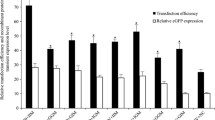Abstract
The generation of cell lines stably expressing recombinant material is a lengthy process and there has thus been much interest in the use of transient expression systems to rapidly produce recombinant material. To achieve this, the DNA of interest must be delivered into the nucleus of the target cell. The mechanisms by which this process occurs are poorly understood and the efficiency of various methods differs widely. Recently, nuclear localization signals (NLSs) have been investigated to target entry of DNA into the nucleus of mammalian cells. We have used NLSs from the SV40 and Tat antigens mixed with our model luciferase reporter gene plasmid for the transfection of Chinese hamster ovary (CHO) cells using calcium phosphate and FuGNE 6 transfection technology. The nocovalent complexation of NLSs with plasmid DNA before calcium phosphate-mediated transfection resulted in enhanced reporter gene expression with increasing ratios of NLS to plasmid until reaching a mximum. At higher ratios than maximum expression, the expression levels decreased. On the other hand, when using FuGENE 6 reagent NLSs did not enhance reporter gene expression. Cell cycle arrest in G2/M phase obliterated the effect of the NLS on reporter gene expression when using the calcium phosphate transfection method.
Similar content being viewed by others
References
Jordan, M. and Wurm, F. (2004) Transfection of adherent and suspended cells by calcium phopsphate. Methods 33, 136–143.
Conti, E. and Izaurralde, E. (2001) Nucleocytoplasmic transport enters the atomic age. Curr. Opin. Cell. Biol. 13, 310–319.
Lanford, R. E. and Butel, J. S. (1984) construction and characterization of an SV40 mutant defective in nuclear transport of T antigen. Cell 37, 801–813.
Escriou, V., Carriere, M., Scherman, D., and Wils, P. (2003) NLS bioconjugates for targeting therapeutic genes to the nucleus. Adv. Drug Deliv. Rev. 55, 295–306.
Batard, P., Jordan, M., and Wurm, F. (2001) Transfer of high copy number plasmid into mammalian cells by calcium phosphate transfection. Gene 70, 61–68.
Graham, F. L. and van der Eb, A. J. (1973) A new technique for the assay of infectivity of human adenovirus 5 DNA. Virology 52, 456–467.
Liu, T., Tang, A., Zhang, G., et al. (2005) Calcium phosphate nanoparticles as a novel nonviral vector for efficient transfection of DNA in cancer gene therapy. Cancer Biother. Radiopharm. 20, 141–149.
Liptay, S., Weidenbach, H., Adler, G., and Schmid, R. M. (1998) Colon epithelium can be transiently transfected with liposomes, calcium phposphate precipitation and DEAE dextran in vivo. Digestion 59, 142–147.
Aronsohn, A. I. and Hughes, J. A. (1998) Nuclear localization signal peptides enhance cationic liposome-mediated gene therapy. J. Drug. Target. 5, 163–169.
Munkonge, F. M., Dean, D. A., Hillery, E., Griesenbach, U., and Alton, E. W. (2003) Emerging significance of plasmid DNA nuclear import in gene therapy. Adv. Drug Deliv. Rev. 55, 749–760.
Arenal, A., Pimentel, R., Garcia, C., Pimentel, ER., and Alesrom, P. (2004) The SV40 T antigen nuclear localization sequence enhances nuclear import of vector DNA in embryos of a crustacean (Litopenacus schmitti). Gene 337, 71–77.
Uyttersprot, N., Costagliola, S., Miot, F. (1998) A new tool for efficient transfection of dog and human thyrocytes in primary culture. Mol. Cell. Endocrinol. 142, 35–39.
Escriou, V., Carriere, M., Bussone, F., Wils, P., and Scherman, D. (2001) Critical assessment of the nuclear import of plasmid during cationic lipid-mediated gene transfer. J. Gene Med. 3, 179–187.
Escriou, V., Ciolina, C., Helbling-Leclerc, A., Wils, P., and Scherman, D. (1998) Cationic lipid-mediated gene transfer: analysis of cellular uptake and nuclear import of plasmid DNA. Cell Biol. Toxicol. 14, 95–104.
El Ouahabi, A., Thiry, M., Pector, V., Fuks, R., Ruysschaert, J. M., and Vandenbranden, M. (1997) The role of endosome destabilizing activity in the gene transfer process mediated by cationic lipids. FEBS Lett. 414, 187–192.
Pramfalk, C., Lanner, J., Andersson, M., et al. (2004) Insulin receptor activation and down-regulation by cationic lipid transfection reagents. BMC Cell Biol. 5, 7.
Zanta, M. A., Belguise-Valladier, P., and Behr, J. P. (1999) Gne delivery: a single nuclear localization signal peptide is sufficient to carry DNA to the cell nucleus. Proc. Natl. Acad. Sci. USA 96, 91–96.
Chowdhury, N. R., Hays, R. M., Bommineni, V. R., et al. (1996) Microtubular disruption prolongs the expression of human bilirubin-uridinediphospho-glucoronateglucuronosyltransferase-1 gene transferred into Gunn rat livers. J. Biol. Chem. 271, 2341–2346.
Son, K. and Huang, L. (1996) Factors inffluencing the drug sensitization of human tumor cells for in situ lipofection. Gene Ther. 3, 630–634.
Lindberg, J., Ferandez, M. A., Ropp, J. D., and Hamm-Alvarez, S. F. (2001) Nocodazole treatment of CV-1 cells enhances nuclear/perinuclear accumulation of lipid-DNA complexes and increases gene expression. Pharm Res. 18, 246–249.
Wang, L. and MacDonald, R. C. (2004) Effects of microtubule-depolymerizing agents on the transfection of cultured vascular smooth muscle cells: enhanced expression with free drug and especially with drug-gene lipoplexes. Mol. Ther. 9, 729–737.
Tait, A. S., Brown, C. J., Galbraith, D. J., et al. (2004) Transdient production of recombinant proteins by Chinese hamster ovary cells using polyethyleneimine/DNA complexes in combination with microtubule disrupting anti-mitotic agents. Biotechnol. Bioeng. 88, 707–721.
Author information
Authors and Affiliations
Corresponding author
Rights and permissions
About this article
Cite this article
Gourbatsi, E., Al-Fageeh, M.B., Marchant, R.J. et al. Noncovalently linked nuclear localization peptides for enhanced calcium phosphate transfection. Mol Biotechnol 33, 1–11 (2006). https://doi.org/10.1385/MB:33:1:1
Issue Date:
DOI: https://doi.org/10.1385/MB:33:1:1




